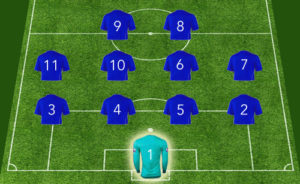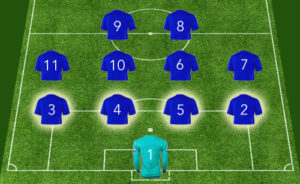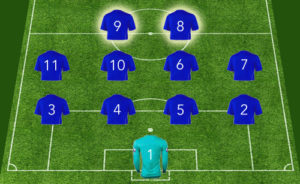The secret to coaching youth soccer positions is to communicate clear instructions to players. People found “3 Things To Tell A Goalkeeper On Gameday” so useful, we decided to extend it. Here are the top 3 things to teach each of the four position roles (goalkeeper, defender, midfielder, and forward).
You could provide more instructions to players based on whether they are in a central or outside role, or other aspects of the game. The following basic instructions will get a good response from your players though as they are simple and easy to understand. A lot of people struggle with coaching youth soccer positions, but with these tips, you won’t have to.
Coaching Youth Soccer Positions: GOALKEEPER

- “Get your whole body behind the ball”
- Move your whole body over. If you don’t catch the ball, it will bounce off of the body and away from the goal.
- When a shot is coming straight at you, make sure not to stick out a foot or a hand to stop the shot.
- When scooping up the ball, kneel down. If the ball goes through your hands it will bounce off of your knee and away from the goal.
- Do not bend over to get it. The ball may go through your hands, then your legs and wind up behind you in the goal.
- If the ball is moving too fast to get your whole body behind it, dive to your side and not on your belly.
- Diving on your belly could allow the ball to sneak into the goal underneath you.
- Diving on your side puts your whole body in the ball’s path.
- This may seem scary, but diving to the side properly does not hurt.
- Get down low as the shot is coming
- Roll over to the side so that you don’t belly flop. First the ankle, then the knee, then the hip, and finally the rest of the body gets on the ground as the arms extend either in front of the chest or above the head.
- Once comfortable with the roll, the player can try to dive further out to the side for spectacular saves.
- This may seem scary, but diving to the side properly does not hurt.
- “Come off of your line”
- You do not have to stay on the goal line to protect the goal, especially in breakaway situations.
- When the other team is on a breakaway, the forward coming at your goal is likely not keeping the ball close to them.
- Wait for the attacker to take a heavy touch forward (kick the ball far from them). As soon as that touch is taken, run out and clear the ball out wide for a throw-in.
- Do not clear the ball up the middle. It will often hit the forward and bounce behind the goalkeeper leaving the forward with an empty net.
- Wait for the attacker to take a heavy touch forward (kick the ball far from them). As soon as that touch is taken, run out and clear the ball out wide for a throw-in.
- “Stay alert”
- Pay attention, especially when the game is boring for you because your team is doing well.
- Soccer is a fast game and the opponent could be on the attack in a matter of seconds.
- You have to be ready for that attack.
- Pay attention, especially when the game is boring for you because your team is doing well.
Coaching Youth Soccer Positions: DEFENDER

- “Stay goalside”
- Get between the player being marked and the goal being defended.
- Stay behind the player and the ball.
- This allows you to step in front of the attacker to intercept the ball.
- If you step in front of the player you are marking, you can see the ball but not where the player is. This can be dangerous for your team.
- Stay behind the player and the ball.
- Get between the player being marked and the goal being defended.
- “Keep your feet”
- This one is also known as “don’t dive in”, but in the spirit of keeping things positive we use “keep your feet”.
- Stand up (contain) the player you are defending and wait for either
- help from a teammate who will steal the ball from the attacker,
- or the attacker to “show the ball”, at which point you can poke it away or steal it from the attacker.
- You do not need to win the ball. You just need to make sure the opposing attacker does not get past you.
- If beaten, try to recover back to goalside before making a tackle.
- You should only “dive in” if you are sure of winning the ball or if you are in desperation (the attacker is about to shoot from a scoring position).
- “Send it wide”
- After winning the ball, get it wide ASAP to a player or a space that is not in your goalmouth (a.k.a. the danger zone).
- Avoid passing the ball towards the center. If it gets intercepted, the opposing attacker will be in a great position to score on your team.
Coaching Youth Soccer Positions: MIDFIELDER

- “Show for the ball (Open up)”
- Help your teammates get the ball to you by moving into space.
- Create a clear path between you and the player in possession of the ball.
- Do not hide behind the opponent.
- “Move the ball”
- Make a quick decision whether to pass or dribble the ball to get past the other team’s midfield.
- Passing the ball always moves it quicker than dribbling it.
- Have an idea where you want to move the ball before it ever gets to you (be aware of where your teammates are and who is open).
- Make a quick decision whether to pass or dribble the ball to get past the other team’s midfield.
- “Track your mark”
- A defensive command that forces midfielders to run with the players they are supposed to be marking as they attack your goal.
- Do not rely on defenders and the goalie to do all of the defending, help them.
- A defensive command that forces midfielders to run with the players they are supposed to be marking as they attack your goal.
Coaching Youth Soccer Positions: FORWARD

- “Be dangerous”
- Whenever a chance presents itself, take a shot on goal or cross the ball into the penalty box.
- Do not force a shot or a cross if you are going to be blocked, but if there is a path between you and the goal/box send the ball there.
- Whenever a chance presents itself, take a shot on goal or cross the ball into the penalty box.
- “Anticipate”
- Assume the best and don’t give up.
- Pressure the opposing defender even when it seems clear that the defender will easily control the ball.
- Assume that the defender will miss the ball and provide you with a chance to score.
- Assume the best and don’t give up.
- “Stay onside”
- Make sure the forward understands the offside rule.
- Pay attention to your position when the ball is not near you so that when the defender does make that mistake you were anticipating you are not penalized with an offside call.

